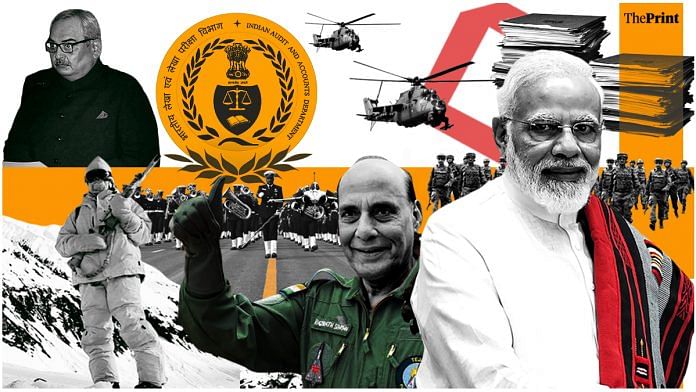The Comptroller and Auditor General has flagged acute shortage and inadequate reserve of equipment and rations for Army troops in high-altitude areas of Siachen, Ladakh and Doklam. The report for November 2015-September 2016 said troops’ calorie intake has fallen by 82 per cent. PM Narendra Modi’s BJP won the 2019 Lok Sabha election on the national security plank after Balakot airstrikes.
ThePrint asks: Has CAG Siachen report exposed Modi govt’s muscular national security pitch as hollow?
Budget constraint is entirely a self-imposed misery because of Army’s inability to thump the table
 Lt Gen Syed Ata Hasnain (Retd)
Lt Gen Syed Ata Hasnain (Retd)
Former GOC of Srinagar-based 15 Corps, associated with the Vivekananda International Foundation and the Institute of Peace and Conflict Studies
The CAG report highlights deficiencies in special clothing and mountaineering equipment (SCME) meant primarily for Siachen glacier, extreme cold clothing and equipment (ECC&E) used in other high-altitude areas, and inadequate special rations.
The first two, which are essential for the survival of soldiers in winter conditions, have a life duration and are usually recycled as ‘part worn serviceable’ (PWS) for maximum economy. Even 10 years ago, there would be an inevitable shortage of snow boots each year and panic would follow. Without serviceable snow boots, survival under extant climatic conditions is almost impossible and unserviceable recycled ones will lead to untold misery for troops.
Availability of such gear and budgetary support for timely procurement are key. The first can be achieved through imports but indigenous manufacturing cannot be put on the back foot either. The budget constraint is largely a self-imposed misery because of the inability of the Army leadership to thump the table. Bureaucratic oversight is also accountable.
This really has little to do with the Narendra Modi government’s ‘muscular’ national security policy since counter-terrorism and counter-insurgency deployment consume only a small portion of the resources. It’s the conventional domain of border security that governments of the past and the present don’t seem to appreciate. Special rations have seen cuts due to poor budgetary allocation — the lowest one since 1962. And I don’t think the situation is likely to improve.
15th Finance Commission’s plans for a non-lapsable fund for defence sector will streamline Army finances
 Deependra Singh Hooda
Deependra Singh Hooda
Former Army Commander, Northern Command
The CAG report raises some serious issues but budgetary cut in military expenditure is nothing new. I see two main problems: low budgetary allocation to the defence sector and tardy procurement procedure.
A stressed budget has an added effect on the lack of funds when it comes to procuring special clothing, high-altitude gear etc. Since the Kargil War, commanders, vice chiefs and senior Army personnel have been given additional financial powers but this has not been adequate.
In 2015, when there was a massive influx of troops into the northern and eastern commands due to new raisings, the Army dipped into its reserves and emergency provisions for rations. This shows that a regular system of procurement and adequate budgetary allocation are required.
The procurement procedure is a sorry state of affairs because delays can go up to four years. The Ministry of Defence and the Army headquarters, in charge of the procurement, should share the blame. Sitting in Delhi, they lack sensitivity towards troops on the ground. This attitude needs to change.
We should also not get the impression that Indian troops battling extreme winter conditions are not being provided for. They are but it is usually out of the reserves and emergency provisions like the Army Commander’s special financial powers. I think the 15th Finance Commission’s plans for a non-lapsable fund for the defence sector will help streamline Army finances.
India has extremely low human capital. CAG report shows that in terms of priorities, tank comes before soldier
 Abhijit Iyer-Mitra
Abhijit Iyer-Mitra
Senior fellow, Institute of Peace and Conflict Studies
The CAG’s findings are nothing new and simply bring to light systemic issues that come up every year. It exposes how naive the Kargil Review Committee’s recommendations were.
The KRC continued the glorious Indian habit of ignoring solutions and pronouncing vague generalities, and adding bureaucratic layers. This was evident a few years ago, when an ammunition shortage was also noticed and reported by the CAG but nothing systemic was done to fix that. All three services have a discretionary funding budget of Rs 300 crore, as does the defence secretary, and the Defence Minister has up to Rs 1,000 crore. The question is: why does the Army never prioritise these purchases and instead prefer large, big-ticket items?
It’s simple really. We are a third-world country with extremely low human capital. The military (including the defence bureaucracy) is a microcosm of India and has extremely little human value addition. We spend on equipment but not on human beings. Most of the shortages listed by the CAG reflect the reality that, on the list of priorities, the soldier is below the tank.
That said, let’s be clear the CAG & KRC were also afflicted by low human capital. So, it’s a vicious cycle of low quality problem identification, low quality recommendation and low quality solutions. The CAG just has to make the best of it.
If there was a will to address these issues, pointed out year after year, then various committees would have scrutinised them
 Ratna Viswanathan
Ratna Viswanathan
Former civil servant, Ministry of Defence
The CAG has been flagging issues of non-procurement of essential items – clothing, equipment or ration – for a very long time. It is a part of the regular audit reportage by Director General of Audit, Defence Services.
Every annual review throws up instances of under-utilisation of budget, delayed or faulty procurement, or procurement that become redundant due to procedural delays. If people were to look at the CAG’s Report on Defence every year, they will find similar issues. And this is not specific to any particular government. Such issues are, however, highlighted when politically expedient.
If there was a will to truly address these issues, pointed out year on year, then they would be scrutinised by various committees set up to review and modernise the armed forces. Linking it to the government’s stated position on force engagement is not the only criteria.
What is relevant is that successive governments take cognisance of the CAG’s annual report on defence and acting on the findings and recommendations of such reports in a focussed, systematic way. Politicising such issues is not going to provide a lasting solution. They are systemic shortcomings that need to be addressed by both the senior management in the armed forces and the government for an effective resolution.
Budget constraints will keep Army’s hands tied when soldiers’ living conditions in Siachen need improvement
 Yusuf T. Unjhawala
Yusuf T. Unjhawala
Editor, Defence Forum India
The CAG report is telling on the budgetary allocation to defence, which has steadily declined in the last few years and reached its lowest as a percentage of GDP since the 1962 war with China. Due to a struggling economy, the government had to juggle between development projects, political compulsions and defence. Even a nationalist government’s first priority is development rather than defence. All three wings of the armed forces have struggled for funds. This hurts both the military’s modernisation plans and operational readiness.
The CAG report on Siachen is not surprising. The reason for non-procurement of the requisite equipment is budget constraints. In fact, the allocation in Budget 2020 barely covers inflation and currency depreciation. In fact, the Indian Air Force has seen its allocation for capital expenditure drop by Rs 1,600 crore.
In Siachen, the Army has done remarkably well to reduce casualties through better technology, training and operating procedures. India had lost 24 soldiers in Siachen to weather in 2011, which came down to five in 2015 as per government reply in the Lok Sabha.
But there is still room for improvement in terms of equipment, living conditions, food and the ability to survive the dreaded avalanches. And budget constraints will continue to tie the Army’s hands.
As Gen Ved Prakash Malik had said during the 1999 Kargil War, the Army will fight with whatever it has. Unfortunately, little has changed since then.
Also read: Modi govt’s CDS-Dept of Military Affairs: Cosmetic change or increasing defence efficiency?
By Pia Krishnankutty, journalist at ThePrint




Never was the Military taken care of well. Military victories were exploited politically by all parties in the past and present. Patriotic rhetoric either by the politicians or the public won’t help the military or the country. Diplomacy will work only to avoid wars for a short term. Conflict is unavoidable in a situation I dia is surrounded by. No politician can understand the implications that are going to arise out of a high intense war. Military should be given a free hand to fight and and also chose what it wants in short term and long term. The best way to avoid a war is to be prepared for a war goes the saying. Our politicians are always preparing for the next elections. For that purpose they use every opportunity and every means including the military’s sacrifices.
The real face of NarendraModi led Government with our own Indian Armed Forces, if,m they done like this how our Brave soldiers fight with Enemy. Only prior Election BJP is remembering our Armed Forces for vote Banking from public by applying fake Patriotism . Very Shame and Sorrow for nation . Very Bad and pity on NDA Government as such type of report revel the actual truth of Tej Bahadur Yadav who has dismissed by Officers Lobby due to truth complaint on non availability of sufficient cum nutricious food
Immediately this problem should be solved, how can a Jawan be under nourished in Siachin n other high altitude areas? Govt should take immediate step for fulfilment.
Almost all significant intelligence unit in ajl major countries knows all about Indian military strength. You think they all come to Indian Republic Day Parade to watch a tank ,elephant and horses parade together in the same road??
I have generally been a supporter of BJP and Modi especially since 2014. Compared to second term, Modi was more decisive and bold in the first term. Abhijit Iyer’s view is right. We value equipment more than people. Worst part of the news is about insufficient ration. How can anyone be committed to the job when he is undernourished or underfed? Regrettably, Modi has lost the guts he showed earlier. He is wailing about Shaheen Bagh protestors blocking the roads, and alleging conspiracies, when Delhi police department is under his control and he could have evicted the protestors at any time.
The PM should take immediate cognizance of the situation in Siachen and initiate suitable corrective action. The budget 2020-21 doesn’t provide any significant increase in allocation of funds to the Defense sector. This also needs to be corrected.